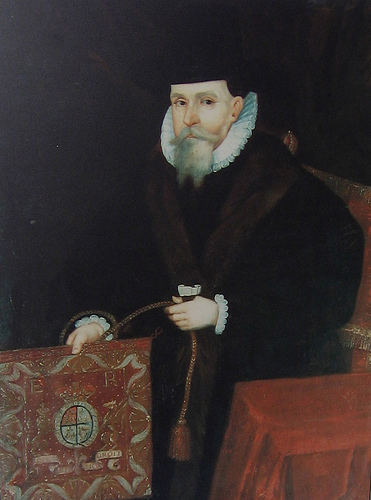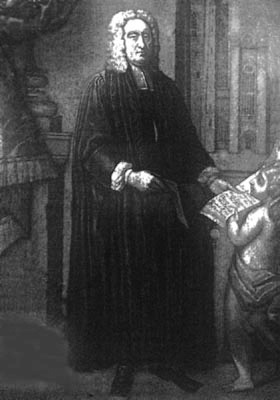|
Thomas Jones (Archbishop)
Thomas Jones ( – 10 April 1619) was Archbishop of Dublin and Lord Chancellor of Ireland. He was also Dean of St. Patrick's Cathedral and Bishop of Meath. He was the patrilineal ancestor of the Viscounts Ranelagh. Early life Jones was born in Middleton, Lancashire, circa 1550. He was a native of Lancashire. He was the son of Henry Jones, Esq. of Middleton. Nothing is known of his mother. His brother, Sir Roger Jones, Alderman of London, was knighted at Whitehall. Thomas acquired a Master of Arts from Christ's College, Cambridge in 1573, after which he relocated to Ireland. He married a widow, Margaret Purdon, who was also a sister-in-law of Archbishop Adam Loftus; she is thought to have been a member of the prominent landowning Purdon family of Ballyclogh, County Cork. His relationship with Loftus proved beneficial to Jones. (). He has been referred to, uncharitably, as Loftus's "pale shadow"; a more balanced view is that the two men thought alike on most issues and so work ... [...More Info...] [...Related Items...] OR: [Wikipedia] [Google] [Baidu] |
Archbishop Of Dublin
The Archbishop of Dublin () is an Episcopal polity, archiepiscopal title which takes its name from Dublin, Republic of Ireland, Ireland. Since the Reformation in Ireland, Reformation, there have been parallel apostolic successions to the title: one in the Catholic Church and the other in the Church of Ireland. The archbishop of each Christian denomination, denomination also holds the title of Primacy of Ireland, Primate of Ireland. History The Roman Catholic Archdiocese of Dublin, diocese of Dublin was formally established by Sigtrygg Silkbeard, Sigtrygg (Sitric) Silkbeard, Kings of Dublin, King of Dublin in 1028, . ''Diocese of Dublin and Glendalough''. Retrieved on 31 March 2010. and the first bishop, Donat, Bishop of Dublin, Dúnán, was consecrated in about the same year. The diocese of Dublin was subject to the Province of ... [...More Info...] [...Related Items...] OR: [Wikipedia] [Google] [Baidu] |
Patrilineal
Patrilineality, also known as the male line, the spear side or agnatic kinship, is a common kinship system in which an individual's family membership derives from and is recorded through their father's lineage. It generally involves the inheritance of property, rights, names, or titles by persons related through male kin. This is sometimes distinguished from cognate kinship, through the mother's lineage, also called the spindle side or the distaff side. A patriline ("father line") is a person's father, and additional ancestors, as traced only through males. In the Bible In the Bible, family and tribal membership appears to be transmitted through the father. For example, a person is considered to be a priest or Levite, if his father is a priest or Levite, and the members of all the Twelve Tribes are called Israelites because their father is Israel (Jacob). In the first lines of the New Testament, the descent of Jesus Christ is counted through the male lineage from Abraham through ... [...More Info...] [...Related Items...] OR: [Wikipedia] [Google] [Baidu] |
Archbishop Of Armagh (Church Of Ireland)
The Anglican archbishop of Armagh is the ecclesiastical head of the Church of Ireland, bearing the title Primate of All Ireland, the metropolitan of the Province of Armagh and the diocesan bishop of the Diocese of Armagh.Diocese of Armagh: Homepage Retrieved on 20 December 2008.'' 2008/2009 (100th edition)'' Church House Publishing (). The traces its history to |
Jonathan Swift
Jonathan Swift (30 November 1667 – 19 October 1745) was an Anglo-Irish writer, essayist, satirist, and Anglican cleric. In 1713, he became the Dean (Christianity), dean of St Patrick's Cathedral, Dublin, and was given the sobriquet "Dean Swift". His trademark deadpan and ironic style of writing, particularly in works such as ''A Modest Proposal'' (1729), has led to such satire being subsequently termed as "Swiftian". He wrote the satirical book ''Gulliver's Travels'' (1726), which became his best-known publication and popularised the fictional island of Lilliput and Blefuscu, Lilliput. Following the remarkable success of his works, Swift came to be regarded by many as the greatest satirist of the Georgian era, and one of the foremost prose satirists in the history of English literature. Swift also authored works such as ''A Tale of a Tub'' (1704) and ''An Argument Against Abolishing Christianity'' (1712). He originally published all of his works under pseudonyms—including L ... [...More Info...] [...Related Items...] OR: [Wikipedia] [Google] [Baidu] |
Coal Mine
Coal mining is the process of resource extraction, extracting coal from the ground or from a mine. Coal is valued for its Energy value of coal, energy content and since the 1880s has been widely used to Electricity generation, generate electricity. Steel and cement industries use coal as a fuel for extraction of iron from iron ore and for cement production. In the United Kingdom and South Africa, a coal mine and its structures are a colliery, a coal mine is called a "pit", and above-ground mining structures are referred to as a "pit head". In Australia, "colliery" generally refers to an underground coal mine. Coal mining has had many developments in recent years, from the early days of men tunneling, digging, and manually extracting the coal on carts to large Open-pit mining, open-cut and Longwall mining, longwall mines. Mining at this scale requires the use of Dragline excavator, draglines, trucks, conveyors, hydraulic jacks, and shearers. The coal mining industry has a long ... [...More Info...] [...Related Items...] OR: [Wikipedia] [Google] [Baidu] |
Adam Loftus (Archbishop)
Adam Loftus (c. 1533 – 5 April 1605) was an English Roman Catholic priest from North Yorkshire who conformed to Anglicanism following the ascension to the throne of Queen Elizabeth I of England. Loftus subsequently served as Church of Ireland Archbishop of Armagh (Church of Ireland), Archbishop of Armagh, Archbishop of Dublin (Church of Ireland), Archbishop of Dublin, and Lord Chancellor of Ireland from 1581. Loftus is particularly important to Irish history as the first List of Provosts of Trinity College Dublin, Provost of Trinity College Dublin and for his central role in the 1584 torture and execution of Archbishop Dermot O'Hurley, who was Beatification, Beatified by Pope John Paul II as one of the Irish Catholic Martyrs in 1992. Loftus is also notable, through the marriage of his daughter Anne to the son and heir of Sir Henry Colley (died 1584), Henry Colley and their subsequent issue, as the ancestor of Arthur Wellesley, 1st Duke of Wellington. Early life Adam Loftus was ... [...More Info...] [...Related Items...] OR: [Wikipedia] [Google] [Baidu] |
Christ's College, Cambridge
Christ's College is a Colleges of the University of Cambridge, constituent college of the University of Cambridge, England. The college includes the Master, the Fellows of the College, and about 450 undergraduate and 250 graduate students. The college was founded by William Byngham in 1437 as God's House. In 1505, the college was granted a new royal charter, was given a substantial endowment by Lady Margaret Beaufort, and changed its name to Christ's College, becoming the twelfth of the Cambridge colleges to be founded in its modern form. Alumni of the college include the poet John Milton, the naturalist Charles Darwin, as well as the Nobel Laureates Martin Evans, James Meade, Alexander R. Todd, Baron Todd, Alexander Todd and Duncan Haldane. The Master is Simon McDonald, Baron McDonald of Salford, Lord McDonald of Salford. History Christ's College was founded by William Byngham in 1437 as God's House, on land which was soon after sold to enable the enlargement of King's Colleg ... [...More Info...] [...Related Items...] OR: [Wikipedia] [Google] [Baidu] |
Master Of Arts
A Master of Arts ( or ''Artium Magister''; abbreviated MA or AM) is the holder of a master's degree awarded by universities in many countries. The degree is usually contrasted with that of Master of Science. Those admitted to the degree have typically studied subjects within the scope of the humanities and social sciences, such as history, literature, languages, linguistics, public administration, political science, communication studies, law or diplomacy; however, different universities have different conventions and may also offer the degree for fields typically considered within the natural sciences and mathematics. The degree can be conferred in respect of completing courses and passing examinations, research, or a combination of the two. The degree of Master of Arts traces its origins to the teaching license or of the University of Paris, designed to produce "masters" who were graduate teachers of their subjects. Europe Czech Republic and Slovakia Like all EU membe ... [...More Info...] [...Related Items...] OR: [Wikipedia] [Google] [Baidu] |
Palace Of Whitehall
The Palace of Whitehall – also spelled White Hall – at Westminster was the main residence of the English monarchs from 1530 until 1698, when most of its structures, with the notable exception of Inigo Jones's Banqueting House of 1622, were destroyed by fire. Henry VIII moved the royal residence to Whitehall after the old royal apartments at the nearby Palace of Westminster were themselves destroyed by fire. Although the Whitehall palace has not survived, the area where it was located is still called Whitehall and has remained a centre of the British government. Whitehall was at one time the largest palace in Europe, with more than 1,500 rooms, before itself being overtaken by the expanding Palace of Versailles, which was to reach 2,400 rooms. At its most expansive, the palace extended over much of the area bordered by Northumberland Avenue in the north; to Downing Street and nearly to Derby Gate in the south; and from roughly the elevations of the current buildings fac ... [...More Info...] [...Related Items...] OR: [Wikipedia] [Google] [Baidu] |
Knight
A knight is a person granted an honorary title of a knighthood by a head of state (including the pope) or representative for service to the monarch, the church, or the country, especially in a military capacity. The concept of a knighthood may have been inspired by the ancient Greek '' hippeis'' (ἱππεῖς) and Roman ''equites''. In the Early Middle Ages in Western Christian Europe, knighthoods were conferred upon mounted warriors. During the High Middle Ages, a knighthood was considered a class of petty nobility. By the Late Middle Ages, the rank had become associated with the ideals of chivalry, a code of conduct for the perfect courtly Christian warrior. Often, a knight was a vassal who served as an elite fighter or a bodyguard for a lord, with payment in the form of land holdings. The lords trusted the knights, who were skilled in battle on horseback. In the Middle Ages, a knighthood was closely linked with horsemanship (and especially the joust) from its orig ... [...More Info...] [...Related Items...] OR: [Wikipedia] [Google] [Baidu] |
Alderman
An alderman is a member of a Municipal government, municipal assembly or council in many jurisdictions founded upon English law with similar officials existing in the Netherlands (wethouder) and Belgium (schepen). The term may be titular, denoting a high-ranking member of a borough or county council, a council member chosen by the elected members themselves rather than by Direct election, popular vote, or a council member elected by voters. Etymology The title is derived from the Old English title of ''ealdorman'', which literally means "elder person", and which was used by the chief nobles presiding over shires. Similar titles exist in other Germanic languages, such as ' in Swedish language, Swedish, ' in Norwegian language, Norwegian, ' in Danish language, Danish and Low German, ' in West Frisian language, West Frisian, ' in Dutch language, Dutch, and ' in German language, German. Finnish language, Finnish also has ', which was borrowed from Swedish. All of these words mean "eld ... [...More Info...] [...Related Items...] OR: [Wikipedia] [Google] [Baidu] |





